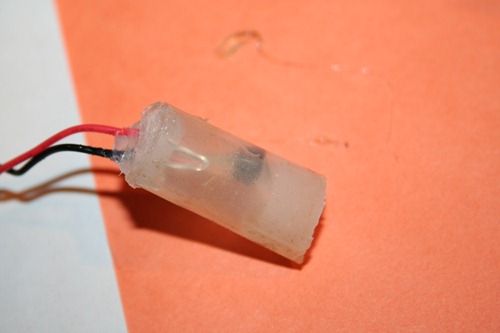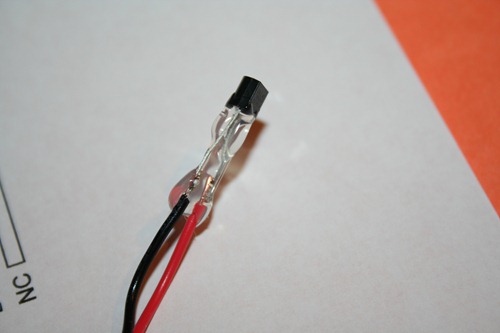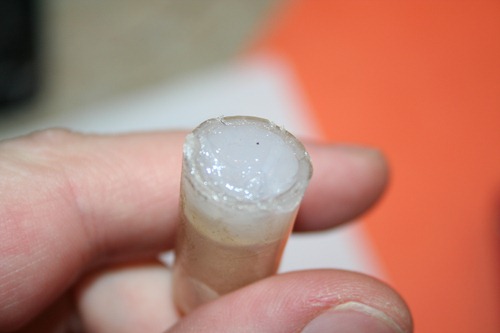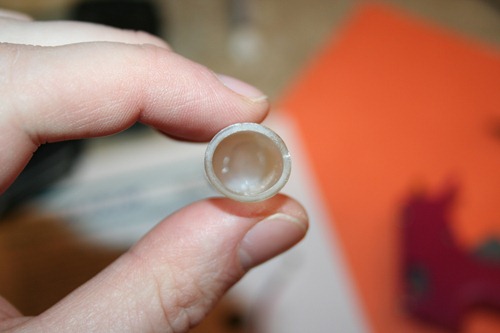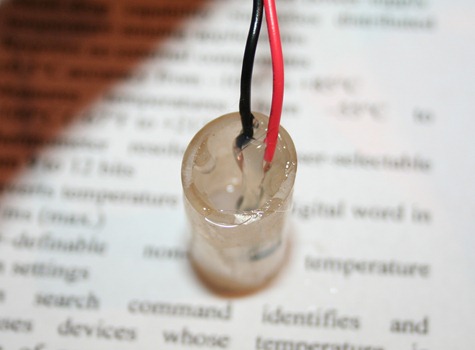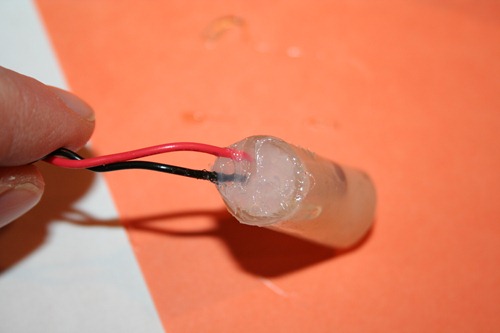Homemade waterproof digital thermometer
14.3 years ago arduino, electronics, thermometer, Uncategorized, waterproof
Now I am playing with hydroponics in my grow box I want to monitor the temperature of my nutrient tank. This is important too hot it can bread disease too cold it can shock your plants. I also want to use the data to identify how ebb/flow cycles affect ambient and solution temperature (for my own nerd curiosity)
I have been thoroughly impressed with the Dallas DS18S20 temperature sensor so decided this would be a great component to use for this project and this is how you can make your own.
Materials:
- DS18S20 temperature sensor
- 1/2 inch plastic tubing (could go smaller but had some lying around)
- Aquarium/food grade silicone
- 18 gauge solid core wire (long enough to get from arduino to what you want to measure)
- Glue gun with glue
- Soldering iron with solder
Construction
Step 1: Solder the two wires to pins 1 and 2 of the DS18S20 and apply a little dab of hot glue to all of the exposed metal. This is not entirely necessary but a small safety precaution so you don’t discover you shorted the connection during assembly.
Step 2: Cut approximately 1 inch length of plastic tubing using a utility knife
Step 3: Apply liberal amount of silicone to one end of the tubing cut in step 2.
Step 4: Allow silicone to set for 15 minutes and do a visual inspection for leaks. You may also try blowing very gently into the tube to check for leaks, though not too hard to create a hole in the process.
Step 5: Attach the DS18S20 to the tube using a drop of hot glue. This is not entirely necessary but when trying to get a perfect watertight seal the less moving parts the better.
Step 6: Again apply a liberal amount of silicone to seal the top paying special attention to the area around the wires
Step 7: Give the silicone at least 24 hours to completely set.
Step 8: Testing. First off the sensor may be buoyant, if this is the case carefully attach a 1/2 hose clamp or something else to help tether it down. Next suspend in a glass of water (preferably clear) and watch for a few minutes for leaks and or bubbles. If you see bubbles try to get an much water as you can out and apply a more silicone and let set for another 24 hours
Hooking it up
This part is pretty straightforward. Pin 1 is your ground and pin 2 is your DQ which for most people doesn’t make much sense but it is a combination power source and bus output. To get this to work you hook up your ground (black wire) to your ground on your arduino and the red wire to digital in and 5v with 4.7K resistor between. Sure that is very confusing so hopefully the breadboard visual below is much more helpful.
Writing the Code
Since I am planning on using this with my grow box controller, I will show how to use this with arduino to get some numbers. You could look at my arduino code in the grow box controller post to get the values but in my case I need to get values from two DS18S20 temperature sensors so I found a great OneWire library which helps make your arduino code very simply. Simple extract the two folders in the zip archive to [ArduinoPath]\hardware\libraries and enter the following code into the arduino UI:
#include <OneWire.h> #include <DallasTemperature.h> OneWire oneWire(8); // on pin 8 DallasTemperature sensors(&oneWire); void setup() { Serial.begin(9600); // Initialize sensors sensors.begin(); } void loop() { sensors.requestTemperatures(); Serial.print(“Sensor #0: “); Serial.println(sensors.getTempCByIndex(0)); Serial.print(“Sensor #1: “); Serial.println(sensors.getTempCByIndex(1)) delay(100); // wait a little time }
If all goes well you should see output similar to the following (values in Celsius):
Sensor #0: 20.3 Sensor #1: 30.4 Sensor #0: 20.3 Sensor #1: 30.4 Sensor #0: 20.3 Sensor #1: 30.4
For people like me who are used to Fahrenheit you can simply use the following equation to convert Celsius to Fahrenheit:
°F = °C x 9/5 + 32
Though I am using this for my grow box controller there are many other uses you could use this for:
- Aquarium temperature monitoring
- Brewing temperature monitoring
- Weather station
- Soil thermometer
Tags: arduino, cheap, growbox, outdoor plants, vegetables
And the winner of the CVG seed stash is…
14.3 years ago Uncategorized
After a week of waiting over a week I haven’t heard back from Aly so I have picked an alternate winner, I reran the CVG Contest Winner Pickorama and the new winner is Angela, please send me an email using the contact link at the top of the page with your name/address and I will get the seeds sent out as soon as possible.
Tags: cheap, garden seeds, vegetables
Cost of Hydroponic Nutrients
14.3 years ago cheap, hydroponics, nutrients
The first time you walk into a hydroponic store there can be a little sticker shock. At first it doesn’t look too bad, $14 for this bottle…oh wait I have to buy these three as well and you leave the store paying $80 to grow some basil and lettuce. Being cheap I like to know how much I will be spending on a hobby before I start out so I did a little exercise.
I took a look at the major nutrient manufacturers and determined using their recommended feeding schedule what it would cost per gallon to complete a 4 week vegetation cycle and a 8 week vegetable and bloom cycle.
To be fair I only included products that provided the primary/secondary macronutrients and micronutrients. Though I am not discounting the effectiveness of various supplements that these companies provide and I wanted to stick with the basics and have a close to an apples to apples comparison as possible.
| Avg, Price | Size | Nutrients Used over 4 weeks (Veg Only) |
Cost per Gallon of mixed nutrients | Nutrients Used over 8 weeks (Veg/Bloom) |
Cost per Gallon of mixed nutrients | |
| General Hydroponics |
$ 1.08 | $ 2.80 | ||||
| FloraGrow | $ 12.50 | qt | 8.08 tsp | $ 0.53 | 12.12 tsp | $ 0.79 |
| FloraBloom | $ 12.50 | qt | 2.02 tsp | $ 0.13 | 14.14 tsp | $ 0.92 |
| FloraMicro | $ 15.95 | qt | 5.05 tsp | $ 0.42 | 13.13 tsp | $ 1.09 |
| Dutch Nutrient Formula |
$ 0.82 | $ 2.30 | ||||
| Advance Grow A |
$ 7.50 | L | 11 tsp | $ 0.41 | 11 tsp | $ 0.41 |
| Advance Grow B |
$ 7.50 | L | 11 tsp | $ 0.41 | 11 tsp | $ 0.41 |
| Advance Flower A |
$ 7.50 | L | 0 tsp | $ – | 20 tsp | $ 0.74 |
| Advance Flower B |
$ 7.50 | L | 0 tsp | $ – | 20 tsp | $ 0.74 |
| Dyna-Gro |
$ 0.66 | $ 2.03 | ||||
| Liquid Grow |
$ 15.00 | qt | 3.5 tsp | $ 0.27 | 3.5 tsp | $ 0.27 |
| Liquid Bloom |
$ 18.95 | qt | 0 tsp | $ – | 7 tsp | $ 0.69 |
| Mag-Pro |
$ 17.95 | qt | 0.875 tsp | $ 0.08 | 3.875 tsp | $ 0.36 |
| Pro-TeKt |
$ 13.90 | qt | 4.25 tsp | $ 0.31 | 9.75 tsp | $ 0.71 |
At first glance these numbers look pretty promising, until you remember the fact that this is the cost per gallon. So if you had a 40 gallon reservoir this can make your cost obvious jump up significantly. Fortunately in my case I only fill my tank up to 9 gallons so a 4 week cycle would cost me on average $7.68 for a 4 week vegetative cycle or $21.39 for a 8 week vegetative and bloom cycle.
Now given I am planning on growing some legal herbs in my hydroponic system (basil/oregano/cilantro) and maybe a little lettuce. This would result in some pretty expensive produce. For this reason and that fact I love chemistry and don’t get to play with it much these days I am planning on going for the less expensive homemade nutrient route, which I will provide more details once I get some more conclusive results of success or failure…
Tags: cheap, cilantro, herb garden, vegetables
pH needs of plants in soil or hydroponics
14.3 years ago hydroponics, pH, water
With the exception of some of my acid loving plants and flowers I normally do not have to worry much about the pH of my soil. This is because I have amended my gardens with nutrient rich soils in raised beds over my alkaline clay I get naturally in my area. This and the fact that due to natural and manmade causes the rainfall is slightly acidic and given the average range for the sweet spot of most edible vegetables (see table below) is 5.8 to 6.0 having your soil slightly acidic this is perfect.
Now when it comes to hydroponics this is entirely different. My tap water has a pH of around 7.5 and the fluctuation of plant using nutrients and transpiration can cause great havoc on the pH on your hydroponic system. Now this creates a challenge but also an opportunity to have control with great precision your pH and keep your plants growing in the sweet spot for the healthiest plants and the greatest yields.
So whether you are growing hydroponically, or simply trying to figure out why your Fennel didn’t do so well last year take a look at the table below, hopefully for some hints of what happened.
Recommended pH Ranges of Vegetables/Herbs
| Plant | Low | High | Plant | Low | High | |
| Artichoke | 6.5 | 7.5 | Millet | 6.0 | 6.5 | |
| Asparagus | 6.0 | 8.0 | Mint | 7.0 | 8.0 | |
| Average | 6.3 | 7.8 | Mushroom | 6.5 | 7.5 | |
| Basil | 5.5 | 6.5 | Mustard | 6.0 | 7.5 | |
| Bean | 6.0 | 7.5 | Okra | 5.5 | 6.0 | |
| Beanroot | 6.0 | 7.5 | Olive | 5.5 | 6.5 | |
| Beet | 6.0 | 6.8 | Onion | 5.5 | 6.5 | |
| Broccoli | 6.0 | 6.8 | Paprika | 7.0 | 8.5 | |
| Brussel Sprouts | 6.0 | 6.8 | Parsley | 5.0 | 7.0 | |
| Cabbage | 6.0 | 6.8 | Parsnip | 6.0 | 6.8 | |
| Calabrese | 6.5 | 7.5 | Pea | 5.8 | 7.0 | |
| Carrot | 6.0 | 6.8 | Peanut | 5.0 | 6.5 | |
| Cauliflower | 6.0 | 6.8 | Pepper | 5.5 | 6.0 | |
| Celery | 6.0 | 6.5 | Peppermint | 6.0 | 7.5 | |
| Chicory | 5.0 | 6.5 | Pistacio | 5.0 | 6.0 | |
| Chinese Cabbage | 6.0 | 7.5 | Potato | 4.5 | 6.5 | |
| Chives | 6.0 | 7.0 | Potato, Sweet | 4.5 | 6.0 | |
| Corn Salad | 6.0 | 6.5 | Pumpkin | 6.0 | 6.8 | |
| Corn, Sweet | 5.8 | 6.8 | Radish | 6.0 | 6.8 | |
| Courgettes | 5.5 | 7.0 | Rice | 5.0 | 6.5 | |
| Cress | 6.0 | 7.0 | Rosemary | 5.0 | 6.0 | |
| Cucumber | 6.0 | 6.8 | Rutabaga | 6.0 | 6.8 | |
| Eggplant | 5.5 | 6.0 | Sage | 5.5 | 6.5 | |
| Fennel | 5.0 | 6.0 | Shallot | 5.5 | 7.0 | |
| Garlic | 5.5 | 7.5 | Sorghum | 5.5 | 7.5 | |
| Ginger | 6.0 | 8.0 | Soybean | 5.5 | 6.5 | |
| Horseradish | 6.0 | 7.0 | Spearmint | 5.5 | 7.5 | |
| Kale | 6.0 | 7.5 | Spinach | 6.0 | 6.5 | |
| Kohlrabi | 6.0 | 6.8 | Squash | 6.0 | 6.8 | |
| Leek | 6.0 | 8.0 | Swede | 5.5 | 7.0 | |
| Lentil | 5.5 | 7.0 | Swiss Chard | 6.0 | 6.5 | |
| Lettuce | 6.0 | 6.5 | Thyme | 5.5 | 7.0 | |
| Marjoram | 6.0 | 7.5 | Tomato | 6.0 | 6.5 | |
| Marrow | 6.0 | 7.5 | Turnip | 6.0 | 6.8 | |
| Melon | 6.0 | 6.8 | Upland Cress | 6.0 | 6.5 |
Tags: garlic bulbs, herb garden, outdoor plants, pepper plants, peppermint plant, tomato plants, vegetables
Cheap Hydroponic Bean sprouter
14.3 years ago cheap, ebb and flow, hydroponics
Maybe not the most hygienic solution but definitely cheap, innovative, and low maintenance. I’ll stick to my ebb and flow design, but thought I would share for those feeling adventurous.
Tags: cheap, outdoor plants, vegetables
Small facelift to site
14.3 years ago Uncategorized
As you may be able to tell I have been doing a little work on the site. I finally got around to moving from Blogger to WordPress, I never had any real problems with Blogger, I just have a few things I want to do with the site that requires me to self-host and WordPress was the way to go.
I am still doing some clean up so please bear with the mess for a little while.
The Cheap Vegetable Gardener
Tags: cheap, vegetables
